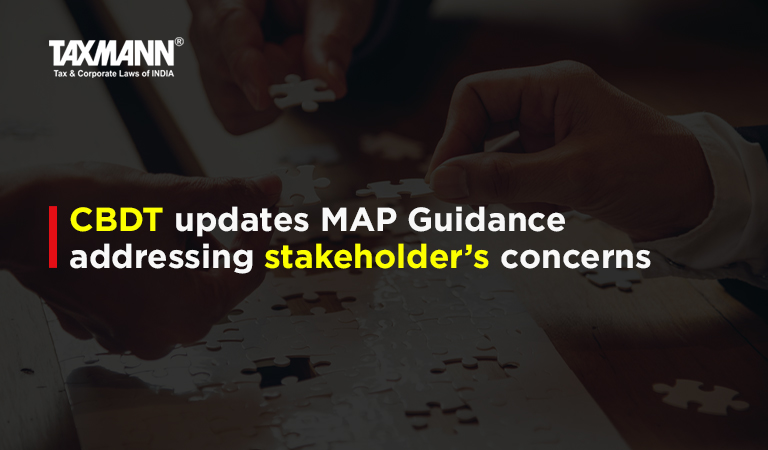CBDT updates MAP Guidance addressing stakeholder’s concerns
- Blog|News|Income Tax|
- 3 Min Read
- By Taxmann
- |
- Last Updated on 16 June, 2022

Notification F. No. 500/09/2016-APA-I, dated 10-06-2022
The Central Board of Direct Taxes (CBDT) vide F. No. 500/09/2016-APA-I, dated 07-08-2020 had issued the Mutual Agreement Procedure (‘MAP’) guidance for the benefit of taxpayers, tax practitioners, tax authorities, and competent authorities (CAs) of India and of treaty partners. The MAP guidance was presented in the following four parts:
a) Part A: Introduction and Basic Information;
b) Part B: Access and Denial of Access to MAP;
c) Part C: Technical Issues; and
d) Part D: Implementation of MAP outcomes.
After the issuance of MAP, stakeholders had raised queries on certain related aspects of MAP, which were not covered by existing guidance. Some partner countries had also requested clarity on certain issues, such as the consequences of the Vivad se Vishwas scheme on MAP.
Considering all these inputs, the CBDT has decided to update the MAP guidance. The following changes have been introduced in the existing MAP guidance:
1. MAP and Vivad se Vishwas Scheme
A new point (f) has been added in Section II of Part B to the MAP guidance to clarify the interplay between MAP and Direct Tax Vivad se Vishwas (VsV) Act. Under this newly added point, the following has been provided:
a) Where a resident taxpayer opted for VsV Scheme for settlement of a case that involves the resolution of transfer pricing adjustments on international transactions, and it is accepted by the tax authorities of India, the competent authorities of the other countries may accept MAP applications from their taxpayers (which are AEs of the Indian taxpayer), and notify the competent authorities of India.
b) The competent authorities of India would allow access to MAP but shall not deviate from the result arrived under the VsV. Instead, they would request the competent authorities of the treaty partners to provide correlative relief.
c) Competent authorities of India shall not provide access to MAP to a non-resident taxpayer who has opted for the VsV scheme on the same issue, because the applicant has given up its legal right to access MAP.
2. New Part E: Applicant’s responsibilities
A new Part E has been added to the MAP guidance to highlight MAP applicants’ responsibilities. The responsibilities of MAP applicants are as under:
2.1. Responsibility of making true disclosure
The updated guidance provides that in item (k) of Form 34F, the applicant should provide all the facts of the case that can materially affect the negotiation process.
For instance, if adjustments have been made to the same international transaction by Indian tax authorities as well as its treaty partner’s tax authorities, the competent authorities of the two countries can be blind-sighted in negotiations if the applicant only mentions adjustments in one jurisdiction and leaves out the crucial fact of adjustments in the other jurisdiction.
2.2. Responsibility to provide up-to-date information
The applicant must keep the competent authorities as up-to-date as possible on all material changes in the information or documentation previously submitted as well as new information or documentation relevant to the issues under consideration.
Making all relevant documentation and information accessible to a competent authority will assist the smooth and efficient operation of the MAP process.
If any element of the MAP guidance comes in conflict with the domestic legislation, rules, instructions, and circulars in India or with the DTAAs entered into by India, the provisions of such domestic legislation, rules, instructions, and circulars or the DTAAs shall prevail.
Click Here To Read The Full Notification
Disclaimer: The content/information published on the website is only for general information of the user and shall not be construed as legal advice. While the Taxmann has exercised reasonable efforts to ensure the veracity of information/content published, Taxmann shall be under no liability in any manner whatsoever for incorrect information, if any.

Taxmann Publications has a dedicated in-house Research & Editorial Team. This team consists of a team of Chartered Accountants, Company Secretaries, and Lawyers. This team works under the guidance and supervision of editor-in-chief Mr Rakesh Bhargava.
The Research and Editorial Team is responsible for developing reliable and accurate content for the readers. The team follows the six-sigma approach to achieve the benchmark of zero error in its publications and research platforms. The team ensures that the following publication guidelines are thoroughly followed while developing the content:
- The statutory material is obtained only from the authorized and reliable sources
- All the latest developments in the judicial and legislative fields are covered
- Prepare the analytical write-ups on current, controversial, and important issues to help the readers to understand the concept and its implications
- Every content published by Taxmann is complete, accurate and lucid
- All evidence-based statements are supported with proper reference to Section, Circular No., Notification No. or citations
- The golden rules of grammar, style and consistency are thoroughly followed
- Font and size that’s easy to read and remain consistent across all imprint and digital publications are applied




